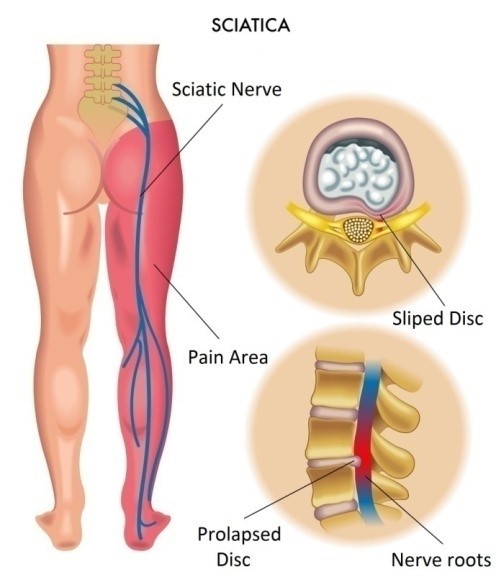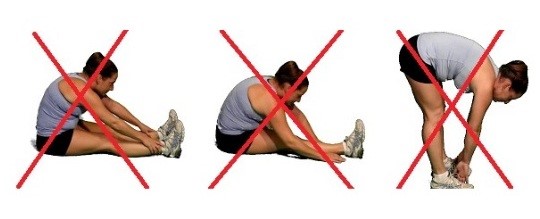

Home Treatment of Sciatica: It is advised to carry on with normal activities as much as possible along with sciatic nerve stretches. Sciatic nerve exercises should be started gently as soon possible. Heat packs to the painful areas may help but care should be taken to avoid scalds. Even the best cream for sciatica pain treatment may not sufficient relief. Similarly, NSAID may not useful in majority of cases. Small, firm cushion between your knees when sleeping on side, or several firm pillows underneath your knees when lying on your back may be helpful.
Our own experience shows, immediate relief for sciatica pain is possible with acupuncture modality. Patient must remain active. Analgesics may help to some extent. It is advised not sit or lie down for long periods – even if moving hurts, it is not harmful and can help get better faster.
Warning signs: Sciatica on both sides; weakness or numbness in both legs that is severe or getting worse; numbness around or under your genitals, or around your bottom (anus); find it hard to start passing urine; cannot control when you urination or defecation. These could be symptoms of a serious back problem that needs to be treated in hospital as soon as possible.Yoga involving forward bending or stretching back of legs can irritate sciatic nerve and exacerbate complaints. Yoga treatment for sciatica pain, especially due to pyriformis muscle can be effective. Tai Chi treatment for sciatica pain may be useful. Qigong treatment for sciatica pain needs special training and can be useful tool of its management. Respect warning signal of pain from body when doing exercises. Exercises must be slowly progressive. Sudden load on muscles or must be avoided. Rule of gentle progress must not be forgotten.
Patients report having taken Ayurvedic treatment for sciatica pain do report some relief also. Similarly, Homeopathic treatment for sciatica pain has also has some satisfied patients. Acupressure treatment for sciatica pain has limited scope.

Slipped disc, also known as disc prolapse or herniated disc, is a common problem that affects the spinal column and produces symptoms of disc problems. The main causes of slipped discs are a degenerative process of aging. The condition is characterized by a bulging disc pressure against the spinal cord or nerves, causing various bulging disc symptoms. Common disc prolapse symptoms include lower back pain, leg pain, weakness in the muscles, numbness, and tingling sensations. In some cases, herniated disc emergency symptoms such as bowel or bladder dysfunction, severe weakness, or loss of sensation in the lower body may require immediate medical attention. If you experience any of these slip disk problems, it is important to seek medical help immediately to prevent any further damage to the spinal cord. A bulging disc in the lumbar spine, such as l4 l5 disc bulge symptoms or l5 s1 disc bulge symptoms can be a painful condition that can significantly impact your quality of life.
Patients report having taken Ayurvedic treatment for sciatica pain do report some relief also. Similarly, Homeopathic treatment for sciatica pain has also has some satisfied patients. Acupressure treatment for sciatica pain has limited scope.
Herniated disc treatment can vary depending on the severity of the condition. For mild cases of disc bulge with an annular tear or disc protrusion treatment can include rest at home, hot or cold compresses, and over-the-counter pain relievers. In some cases, disc problem treatment at home may be sufficient, including rest, ice, and over-the-counter pain relievers. In addition, slipped disc treatment at home may include stretching exercises recommended by a doctor or physical therapist. However, for a more severe disc bulge with annular tear treatment options may include physical therapy, spinal injections, or surgery. A slipped disc treatment without surgery may involve chiropractic adjustments, acupuncture, or massage therapy. Treatment for herniated discs and sciatica typically involves a combination of therapies, including medication, physical therapy, and possibly surgery. Ultimately, the best bulging disc treatment plan will depend on the individual's specific symptoms and the extent of the disc problem, so it's important to consult with a qualified medical professional to determine the most appropriate treatment approach.
While surgery may be recommended as lumbar slipped disc treatment in some cases, there are several non-surgical L5 S1 disc bulge treatment options available for those with a lumbar disc bulge who wish to avoid surgery. L3 L4 L5 disc bulge treatment options may include physical therapy exercises that focus on strengthening the muscles of the lower back and improving flexibility, over-the-counter pain relievers, and hot or cold compresses to help manage pain and reduce inflammation. In some cases, medication or steroid injections may be recommended to help manage pain and inflammation for l3 l4 disc bulge treatment. Treatment for an L4 L5 disc bulge without surgery may include physical therapy exercises, over-the-counter pain relievers, hot or cold compresses, medication, steroid injections, and lifestyle modifications. Additionally, lumbar hernia treatment includes lifestyle modifications such as maintaining a healthy weight, quitting smoking, and reducing alcohol consumption. If non-surgical treatment options are not effective, surgical intervention such as an L 5 S1 herniated disc surgery may be recommended. Treatment for an L4 L5 disc bulge without surgery may include physical therapy exercises, over-the-counter pain relievers, hot or cold compresses, medication, steroid injections, and lifestyle modifications.
Physical therapy can be an effective treatment option for individuals with a herniated or slipped disc, with PIVD physiotherapy treatment being a popular approach that focuses on relieving pain and improving mobility through exercises and stretches that target the affected area of the spine, as well as the surrounding muscles and joints. Physical therapy for herniated discs may also involve the use of specialized equipment, such as traction machines or ultrasound therapy, to help reduce inflammation and promote healing. In addition, physical therapy for slipped discs can include education on proper body mechanics and posture to prevent further injury or discomfort, as well as guidance on lifestyle changes that can support overall spinal health. Overall, physical therapy can be an effective and non-invasive treatment option for individuals with a herniated or slipped disc, helping them to manage symptoms and improve their quality of life.
When non-invasive treatment options for a herniated or bulging disc are not effective, surgery may be recommended to alleviate symptoms and restore function to the affected area of the spine. Bulging disc surgery involves removing the damaged portion of the disc to reduce pressure on the affected nerves in the spine. Microdiscectomy surgery and discectomy surgery are two common procedures that involve the removal of the damaged portion of the disc to reduce pressure on nearby nerves. Laser surgery for herniated discs and disc compression surgery are other minimally invasive options that can be used to treat disc problems. Lumbar herniated disc surgery may be recommended for individuals experiencing lower back pain, sciatica, or other symptoms that are impacting their quality of life. The slipped disc surgery cost or herniated disc surgery cost can vary depending on a range of factors, including the specific procedure being performed, the location of the surgery, and whether or not insurance is covering the cost.
“my experience with acupuncture was very positive, and it provided almost instant relief. After 10 sessions, I was pain free, and I credit a big part of my healing to it. I continue to work on staying pain free by doing my stretches and getting acupuncture as needed. I hope my story can give anyone searching for natural pain remedies hope.”
“CONCLUSION:Acupuncture can relieve the symptoms of sciatica with the increase of pain threshold.”
The cause is usually a herniated disk in the spine or an overgrowth of bone, sometimes called bone spurs, form on the spinal bones. Sciatica occurs when the sciatic nerve becomes pinched. Sometimes even irritation of sciatic nerve without pinching also results in sciatica pain. More rarely, a tumor can put pressure on the nerve. Or a disease such as diabetes can damage the nerve.
सायाटीकाच्या वेदना कमी करण्यासाठी आणि तुम्हाला चांगले कार्य करण्यास मदत करण्यासाठी बर्फाचे पॅक आणि उष्णता दोन्ही वापरले जाऊ शकतात.
पहिले सात दिवस बर्फ वापरा. सायटॅटिक नर्व्हची जळजळ कमी करण्यासाठी तुमच्या पाठीच्या खालच्या बाजूला बर्फाचे पॅक ठेवा. स्वतःला फ्रॉस्टबाइट न देण्याची काळजी घ्या. Icepacks थेट त्वचेला स्पर्श करू नये; त्यांना कापड किंवा टॉवेलमध्ये गुंडाळा. त्यांना एका वेळी 15 ते 20 मिनिटांपेक्षा जास्त वेळ सोडू नका, त्या दरम्यान किमान 15 ते 20 मिनिटांचा ब्रेक घ्या. ऑन-ऑफ-ऑन-ऑफ-ऑन सायकल वापरून पहा (याला 75 ते 100 मिनिटे लागतील). मग तुम्हाला कसे वाटते ते पाहण्यासाठी ब्रेक घ्या.
बर्फाच्या वापरादरम्यान काही हळुवार ताणून पाहणे ठीक आहे, परंतु क्षेत्र उबदार होण्यासाठी अर्धा तास प्रतीक्षा करणे चांगले आहे. दररोज तीन ते पाच अर्ज केल्याने काही वेदना कमी होण्यास मदत होऊ शकते.
हालचाल ही कदाचित सर्वात महत्वाची गोष्ट आहे जी तुम्ही तुमच्या वेदनांना मदत करण्यासाठी करू शकता.
सायाटीकाच्या वेदना सुरू झाल्यानंतर पहिले दोन दिवस विश्रांती घेणे ठीक आहे; त्यानंतर, अंथरुणावर राहिल्याने गोष्टी अधिक वाईट होतात, चांगले नाही. हलवण्यामुळे तुमच्या वेदनांना अनेक प्रकारे मदत होते:
तुम्हाला सायाटीकाचे असल्यास, शक्य तितक्या लवकर हलवा. हालचाल केल्याने वेदना आणखी वाढल्यासारखे वाटत असल्यास, डॉक्टरांना भेटणे आणि काय चालले आहे याबद्दल बोलणे चांगले.
एकदा तुमचा सायाटीका नियंत्रणात आला की, तो परत येण्याची शक्यता कमी करण्यासाठी हलवत रहा. जास्त वेळ बसणे कोणासाठीही चांगले नाही. लांबलचक बसल्याने तुमचा कटिप्रदेशाचा धोका वाढू शकतो आणि एकदा तुम्हाला सायटिका वाढू शकते.
सायाटीका के दर्द को कम करने और आपको बेहतर कार्य करने में मदद करने के लिए आइस पैक और गर्मी दोनों का उपयोग किया जा सकता है।
पहले सात दिनों तक बर्फ का प्रयोग करें। सायाटीका तंत्रिका की सूजन को कम करने के लिए अपनी पीठ के निचले हिस्से पर आइस पैक लगाएं। अपने आप को शीतदंश न देने के लिए सावधान रहें। आइसपैक सीधे त्वचा को नहीं छूना चाहिए; उन्हें कपड़े या तौलिये में लपेट दें। उन्हें एक बार में 15 से 20 मिनट के लिए जगह पर छोड़ दें, बीच में कम से कम 15 से 20 मिनट का ब्रेक लें। ऑन-ऑफ-ऑन-ऑफ-ऑन के चक्र का प्रयास करें (इसमें 75 और 100 मिनट के बीच का समय लगेगा)। फिर यह देखने के लिए ब्रेक लें कि आप कैसा महसूस करते हैं।
बर्फ के अनुप्रयोगों के बीच कुछ कोमल हिस्सों की कोशिश करना ठीक है, हालांकि क्षेत्र के गर्म होने के लिए लगभग आधे घंटे का इंतजार करना बेहतर है। प्रति दिन तीन से पांच आवेदन कुछ दर्द से राहत दिलाने में मदद कर सकते हैं।
चलना शायद सबसे महत्वपूर्ण काम है जो आप अपने दर्द को दूर करने के लिए कर सकते हैं। साइटिका का दर्द शुरू होने के बाद पहले कुछ दिनों तक आराम करना ठीक है; उसके बाद, बिस्तर पर रहने से आमतौर पर चीजें बदतर हो जाती हैं, बेहतर नहीं। चलने से आपके दर्द में कई तरह से मदद मिलती है:
अगर आपको साइटिका है तो जितना जल्दी हो सके उतना हिलें-डुलें। अगर हिलने-डुलने से दर्द और बढ़ जाता है, तो बेहतर होगा कि डॉक्टर से मिलें और बात करें कि क्या हो रहा है। साइटिका के नियंत्रण में आने के बाद, इसके वापस आने की संभावना को कम करने के लिए चलते रहें। लंबे समय तक बैठे रहना किसी के लिए भी अच्छा नहीं होता है। लंबे समय तक बैठे रहने से साइटिका का खतरा बढ़ सकता है और एक बार साइटिका होने पर यह और भी बदतर हो सकता है।